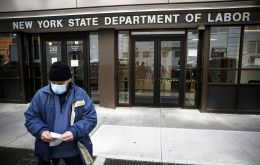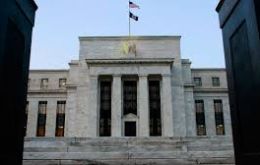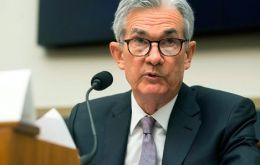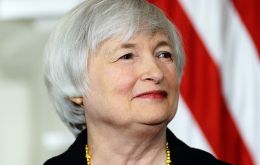MercoPress. South Atlantic News Agency
Tag: Federal Open Market Committee (FOMC)
-
Thursday, June 15th 2023 - 06:50 UTC
Fed makes a pause, leaves rates unchanged but anticipates two further moves before 2024

The United States Federal Reserve this Wednesday, following a two-day meeting decided to keep the interest rate unchanged but the Federal Open Market Committee anticipated that a further two hikes of quarter percentage moves can be expected before the end of the year.
-
Thursday, July 29th 2021 - 07:58 UTC
Fed leaves rates unchanged but admits inflation could force a change of policy

The United States Federal Reserve kept interest rates unchanged, close to zero, despite an inflation spike during June when it soared to an annual 5,4%, its highest in thirteen years.
-
Thursday, April 30th 2020 - 07:28 UTC
Fed admits public health situation will “weigh heavily on economic activity, jobs and inflation”

The Federal Reserve on Wednesday left interest rates near zero and repeated a vow to do what it takes to shore up the U.S. economy amid an ongoing coronavirus pandemic that will not only “weigh heavily” on the near-term outlook but poses “considerable risks” for the medium term as well.
-
Wednesday, September 26th 2018 - 21:13 UTC
Fed raises interest rate and announces a third increase this year

The United States Federal Reserve announced on Wednesday, after a two-day policy meeting, that it would raise interest rates for the third time this year. The decision, which had been widely expected, raised the federal funds rate by 25 basis points, to a range of 2% to 2.25%.
-
Wednesday, May 2nd 2018 - 20:45 UTC
Fed leaves rates unchanged, confirms inflation near 2% target; hike expected at June meeting

The Federal Reserve on Wednesday left its benchmark interest rate unchanged, confirmed that inflation is near its 2% target, and strangely enough did not mention a word about the looming international trade confrontation. The central bank after a two-day meeting said inflation over the next 12 months should “run near” the 2% target, updating its language from March that indicated inflation would “move up” towards that level.
-
Thursday, July 28th 2016 - 13:04 UTC
Fed sees current conditions remaining unchanged, at least until December

The United States Federal Reserve on Thursday left key interest rates untouched but acknowledged improved economic performance, suggesting a rate increase may be on the horizon in 2016.
-
Saturday, August 23rd 2014 - 06:18 UTC
Yellen insists with expansive policies despite growing pressure from 'hawks' on interest rate

Federal Reserve Chair Janet Yellen said Friday that the US jobs market has not yet fully recovered, but acknowledged that data is sending mixed signals, spurring debate over inflationary pressures. In a speech to leading central bankers in Jackson Hole, Wyoming, Yellen, who has kept Fed policy expansive due to perceived excess slack in the jobs market, gave no clear new signs for monetary policy.
-
Thursday, July 31st 2014 - 07:13 UTC
Fed further tapers bond-buying program but concerned with labor market

The Federal Reserve said on Wednesday that US growth in economic activity rebounded in the second quarter and labor market conditions improved, with the unemployment rate declining further. However, a range of labor market indicators suggests that there remains significant “underutilization of labor resources”.
-
Thursday, May 1st 2014 - 06:58 UTC
Fed optimistic about US economy; pares securities purchases by another 10bn dollars

The Federal Reserve looked past a dismal reading on first quarter US growth and gave a mostly upbeat assessment of the economy's prospects as it announced another cut in its massive bond-buying stimulus. Latest information indicates that economic activity has picked up after having slowed sharply during the winter in part because of adverse weather conditions, the central bank said on Wednesday.
-
Thursday, February 20th 2014 - 04:18 UTC
IMF concerned with risks in emerging markets from pulling back stimulus too quickly

Advanced economies, including the United States, must avoid pulling back stimulus too quickly given the weak global economic recovery and recent market volatility highlights key risks in some emerging markets, the International Monetary Fund said on Wednesday.
